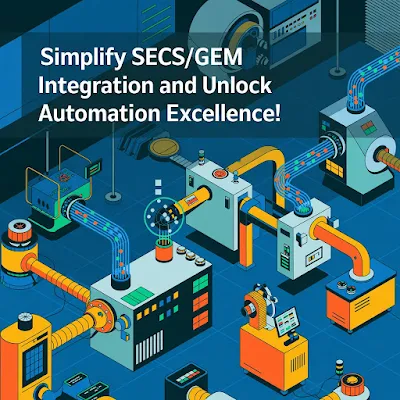The semiconductor industry is witnessing a paradigm shift as advanced packaging technologies merge manufacturing and packaging processes into a seamless ecosystem. This integration not only streamlines production but also enables greater efficiency, performance, and reliability. At the heart of this transformation lies the SECS/GEM protocol, a critical enabler for communication between semiconductor equipment and host systems. By facilitating real-time data exchange and automation, SECS GEM is reshaping how advanced packaging and semiconductor manufacturing operate in harmony.
Introduction to Advanced Packaging and SECS/GEM
Advanced packaging has evolved beyond its traditional role of housing semiconductor devices. Today, it is an integral part of achieving enhanced device functionality. Techniques such as chiplet integration, fan-out wafer-level packaging, and 3D stacking have become the cornerstone of modern electronics. However, these intricate processes demand precise coordination, which is where the SECS/GEM communication protocol comes into play.
The SECS (SEMI Equipment Communication Standard)/GEM (Generic Equipment Model) protocol ensures seamless data transfer between equipment and host systems in semiconductor fabs. Its applications extend to advanced packaging lines, enabling manufacturers to synchronize equipment actions, monitor production in real-time, and minimize downtime. As advanced packaging blurs the lines between manufacturing and packaging, SECS/GEM integration becomes indispensable.
How SECS/GEM is Transforming Advanced Packaging
The advanced packaging process involves multiple steps, such as wafer handling, die attachment, and thermal management, each requiring high precision and repeatability. SECS/GEM software facilitates this by providing a robust communication framework that connects equipment and the central manufacturing execution system (MES). This integration enables advanced features such as recipe management, process control, and equipment monitoring, all of which are vital for modern packaging techniques.
Enabling Seamless Equipment Communication
The SECS/GEM interface ensures that all equipment within the advanced packaging line communicates efficiently. For instance, during chiplet integration, multiple machines must collaborate to achieve accurate alignment and bonding. The SECS/GEM communication protocol allows real-time status updates and error reporting, ensuring that any deviations are addressed promptly.
Streamlining Automation Through GEM300
GEM300, an extension of the SECS/GEM standard, brings added functionalities for high-volume semiconductor manufacturing. This standard is crucial for automating advanced packaging lines, enabling features such as carrier management and lot tracking. By leveraging GEM300 and SECS/GEM integration, manufacturers can achieve higher yields and reduced cycle times.
Enhanced Data Analysis for Process Optimization
SECS/GEM software collects a wealth of data during production, which can be analyzed to improve processes and detect inefficiencies. This is particularly beneficial in advanced packaging, where even minor inconsistencies can impact device performance. The protocol's ability to facilitate data exchange in real-time helps manufacturers optimize their processes continually.
Benefits of SECS/GEM Integration in Advanced Packaging
The integration of SECS/GEM communication into advanced packaging offers several advantages:
Improved Yield and Quality: With precise equipment coordination and real-time monitoring, SECS/GEM minimizes errors during critical packaging steps.
Reduced Operational Costs: By automating processes and reducing manual intervention, manufacturers can lower costs while maintaining high throughput.
Scalability: SECS/GEM's modular design allows it to adapt to different equipment configurations, making it ideal for diverse packaging requirements.
For example, during fan-out wafer-level packaging, precise placement of dies is essential. The SECS/GEM interface ensures that equipment operates within predefined parameters, reducing the likelihood of errors and improving overall efficiency.
Future Prospects of SECS/GEM in Semiconductor Manufacturing
As the semiconductor industry continues to push the boundaries of miniaturization and performance, the role of advanced packaging will grow in significance. SECS/GEM communication will remain pivotal in supporting this evolution. Innovations such as AI-driven process controls and predictive maintenance will further enhance the capabilities of SECS/GEM software, ensuring that semiconductor manufacturing and packaging remain tightly integrated.
The adoption of emerging technologies like 2.5D and 3D integration will also benefit from SECS/GEM communication protocols. These techniques demand an unprecedented level of equipment synchronization and data exchange, which SECS/GEM can readily provide.
Advanced packaging is not just a complementary step to semiconductor manufacturing—it is becoming an integral part of it. The SECS/GEM protocol plays a crucial role in merging these processes, offering a robust framework for equipment communication, automation, and optimization. By leveraging SECS/GEM communication and its extensions like GEM300, manufacturers can achieve new levels of efficiency and innovation.
As the semiconductor landscape continues to evolve, the importance of SECS/GEM integration will only grow. Whether through enhanced data analysis, seamless equipment communication, or robust automation, the SECS/GEM interface is at the forefront of driving the future of advanced packaging.
More Blog Post:
- Unlocking Efficiency: How SECS/GEM Leverages Cloud Computing for Smart Manufacturing
- Are you struggling to achieve seamless SECS/GEM communication with your OEM's solution?
- Are you looking for better SECS/GEM capabilities than what your OEM offers?
- SECS/GEM Compliance: Ensuring Standardization in Semiconductor Manufacturing

